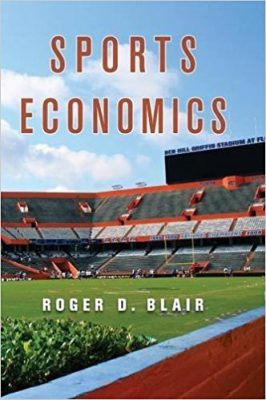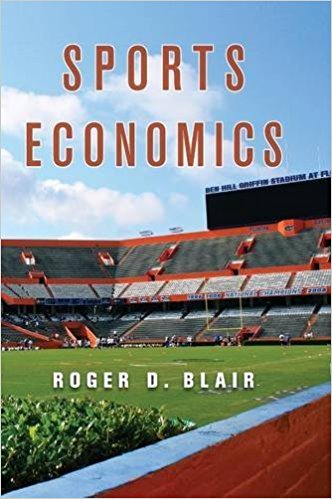 Author: Roger D. Blair
Author: Roger D. Blair
Publisher: Cambridge University Press – 530 pages
Book Review by: Sonu Chandiram
Sports is a big business in the United States, particularly when you look at professional sports. The ‘Big Five’ major leagues – National Football League (NFL), Major League Baseball (MLB), Major League Soccer (MLS), the National Basketball Association (NBA), and the National Hockey League (NHL) generated over $32 billion in combined revenues from ticket sales in 2015, according to Wikipedia.
Add to this the $12 billion received by the these leagues from four of the largest U.S. television networks – ABC, CBS, NBC, and Fox – and you are looking at around $44 billion in revenues. This does not include monies received from sales of products of the 120+ professional teams that are members of these leagues.
The average number of fans attending the games of these leagues has also been growing. In 2015, the average NFL game was attended by 68,400 fans. For MLB, it was 30,517 attendees. MLS had 21,574 attendees, NBA had 17,864 fans per game, and NHL, 17,481 fans, for a combined average total of 155,836 fans attending the games of these major professional sports leagues. This grew 6.5 percent from 146,360 attending fans six years earlier, in 2009
This book by economics professor Roger D. Blair of the University of Florida provides quite a detailed look at the business and economics aspects of major professional sports played in the United States: baseball, basketball, football, hickey, and soccer. It is also very likely one of the most comprehensive texts on sports economics.
Through its over 500 pages, Roger Blair delves into the various money-related activities of professional and collegiate sports from the revenue and cost sides. Matters related to pricing tickets, selling broadcasting (radio and television) rights, and other revenue streams are discussed at length in this book.
Recruiting, negotiating contracts with, compensating, and insuring players, building and maintaining sports arenas and other facilities, as well as advertising the games and other costs are discussed at length in this one-of a kind, extensive text.
Management and control issues such as cheating in the games, ensuring discipline, dealing with drug use, gambling, and other types of misconduct of the players are also taken up in this unique book that has become an Amazon bestseller.
Here below are the titles of the components of this volume, including its 25 chapters. This overview of its contents provided below, helps you the student or reader to choose which parts to read first in this lengthy work, ensuring efficient use of your time:
- Introduction
- Introduction to Sports Economics
- The Business of Sports
- Sports Leagues and Organizations
- Competitive Balance
- The Sports Business
- Pricing Decisions
- Advertising in the Sports Industry
- The Market for Sports Broadcasting Rights
- Insuring Player Talent
- Sports Leagues and Antitrust Policy
- Image and Integrity
- Sports Gambling
- Cheating in Sports
- Misconduct and Discipline
- Steroids and Other Performance-Enhancing Drugs
- Facilities, Franchises, and Public Policy
- Competing for Sports Franchises and Events
- Economic Impact of Sports Events
- Financing Sports Facilities
- Sports Labor Market
- Salary Determination: Competition and Monopsony
- The National Collegiate Athletic Association as a Collusive Monopsony
- Salary Determination: Bidding and Bargaining
- Economic Value of Multiyear Contracts
- Final Offer Arbitration in Major League Baseball
- Players’ Unions and Collective Bargaining
- The Role of Sports Agents
- Should an Athlete Turn ‘Pro’ Early?
- Discrimination in Sports
This is probably one of the best-researched, superbly organized, and most well-written books available today on the market on the business and economics of professional and major league sports in the United States. It is a treasure particularly for those who are in the sports business
Author:
Roger D. Blair is Walter G. Matherly Professor and Chair of the Department of Economics at the University of Florida, where he has taught since 1970. He received his PhD from Michigan State University. Professor Blair is the author and coauthor of numerous books.
Among them are Antitrust Economics (with David Kaserman), Law and Economics of Vertical Integration and Control (with David Kaserman), Monopsony: Antitrust Law and Economics (with Jeffrey Harrison), Monpsony in Law and Economics (with Jeffrey Harrison), Intellectual Property: Economic and Legal Dimensions of Rights and Remedies (with Thomas Cotter), The Economics of Franchising (with Francine Lafontaine), and Volume II of Antitrust Law (with Herbert Hovenkamp, Christine Dorrance, and Philip Areeda).
He is also the editor or coeditor of many volumes, including Proving Antitrust Damages. Professor Blair has written more than 170 articles or chapters in professional economic journals, law reviews, and books.







